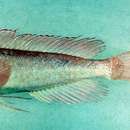fr
noms dans le fil d’Ariane


Owstonia és un gènere de peixos pertanyent a la família dels cepòlids.[3]
Owstonia ist eine artenreiche Gattung der Bandfische (Cepolidae). Die Fische leben über Hartböden im Indopazifik von der Ostküste Afrikas bis Australien, sowie Japan im Norden und Neukaledonien im Osten in Tiefen von 155 bis 550 Metern. Die Gattung wurde nach Alan Owston (1853‒1915) benannt, einem Amateur-Naturforscher, der sich vor allem mit asiatischen Tieren beschäftigte.[1]
Wie alle Bandfische sind Owstonia-Arten langgestreckt und seitlich abgeflacht. Ausgewachsen erreichen sie Standardlängen von 7 (O. sarmiento) bis 40,8 cm (O. kamoharai). Von den drei anderen Bandfischgattungen (Unterfamilie Cepolinae) unterscheiden sie sich vor allem dadurch, dass Rücken-, After- und Schwanzflosse nicht zusammengewachsen sind. Die Schwanzflosse ist ungegabelt mit lang ausgezogenen mittleren Flossenstrahlen bei den meisten Arten. Die Flossenstrahlen von Rücken- und Afterflosse sind dünn und flexibel. Owstonia-Arten haben Rundschuppen. Rücken- und Afterflosse sind unbeschuppt. Bei den meisten Arten sind auch die „Wangen“ schuppenlos. Die Anzahl der Kiemenreusenstrahlen liegt bei den adulten Fischen bei 30 bis 60, die Anzahl der Branchiostegalstrahlen beträgt sechs. Der untere Rand des Präoperculums kann glatt oder schwach gesägt sein, aber auch kräftige Stacheln tragen. Das Maul ist groß, endständig und steht schräg nach oben. Die Prämaxillare ist bei den meisten Arten dunkel pigmentiert (nicht bei O. hawaiiensis, O. ignota und bei den meisten Exemplaren von O. psilos). Der Gaumen ist zahnlos. Die Schwimmblase ist gut entwickelt.
Zum Vergleich die Flossenformel und Wirbelzahl der übrigen Bandfische:
Außerdem gibt es weitere, bisher unbeschriebene Arten.[1]
Owstonia ist eine artenreiche Gattung der Bandfische (Cepolidae). Die Fische leben über Hartböden im Indopazifik von der Ostküste Afrikas bis Australien, sowie Japan im Norden und Neukaledonien im Osten in Tiefen von 155 bis 550 Metern. Die Gattung wurde nach Alan Owston (1853‒1915) benannt, einem Amateur-Naturforscher, der sich vor allem mit asiatischen Tieren beschäftigte.
Owstonia is a genus of marine ray-finned fish belonging to the family Cepolidae, the bandfishes. It is the only genus in the monotypic subfamily Owstoninae. They are found in deep-waters of the Indian and Pacific Ocean.
Owstonia was described in 1908 by the Japanese ichthyologist Shigeho Tanaka with the type species designated as Owstonia totomiensis due to it being the only species in a monotypic genus at the time of its description.[1] In 1913 Tanaka, along with the American ichthyologists David Starr Jordan and John Otterbein Snyder, created the family Owstonidae for this genus.[3] The family was merged with the Cepolidae as a subfamily in 1956[4] and is now regarded as a subfamily, Owstoninae, of the Cepolidae.[5] The name of the genus, Owstonia. means "belonging to Owston". This name refers to a specimen of O. totomiensis being found in the collection of Alan Owston.[6]
There are currently 36 recognized species in this genus:[7][4]
Owstonia bandfishes differ from the two genera in the subfamily Cepolinae by being less elongate, having only 27-33 vertebrae and 19-26 soft rays in their dorsal fin. Their dorsal and anal fins not attached to the lanceoloate caudal fin.[9] They vary in maximum total length from 5.4 cm (2.1 in) in O. nalani to 52 cm (20 in) in O. weberi.[7]
Owstonia bandfishes are found in the Indo-Pacific region from the eastern coast of Africa as far east as Hawaii.[7] They are found in deep water.[5] Unlike the Cepoline bandfishes the fishes in Owstonia are not, other than one species, burrowers in soft substrates. They are found over rocky substrates swimming close to the bottom particularly on the upper continental slope, around atolls or oceanic fragments of crust. The exception is O. taeniosoma which has a more elongated body than its congeners and is found over sand or mud bottoms on the continental shelf.[4]
Owstonia is a genus of marine ray-finned fish belonging to the family Cepolidae, the bandfishes. It is the only genus in the monotypic subfamily Owstoninae. They are found in deep-waters of the Indian and Pacific Ocean.
Owstonia es un género de peces de la familia Cepolidae, del orden Perciformes. Este género marino fue descrito científicamente por Shigeho Tanaka en 1908.
Especies reconocidas del género:
Owstonia es un género de peces de la familia Cepolidae, del orden Perciformes. Este género marino fue descrito científicamente por Shigeho Tanaka en 1908.
Owstonia is een geslacht van straalvinnige vissen uit de familie van lintvissen (Cepolidae).[1] Het geslacht is voor het eerst wetenschappelijk beschreven in 1908 door Tanaka.
Owstonia is een geslacht van straalvinnige vissen uit de familie van lintvissen (Cepolidae). Het geslacht is voor het eerst wetenschappelijk beschreven in 1908 door Tanaka.